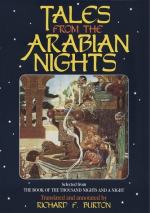[FN#70] As might be expected from a nation of camel-breeders actual cautery which can cause only counter-irritation, is a favourite nostrum; and the Hadis or prophetic saying is “Akhir al-dawa (or al-tibb) al-Kayy” = cautery is the end of medicine-cure; and “Fire and sickness cannot cohabit.” Most of the Badawi bear upon their bodies grisly marks Of this heroic treatment, whose abuse not unfrequently brings on gangrene. The Hadis (Burckhardt, Proverbs, No. 30) also means “if nothing else avail, take violent measures.
[FN#71] The Spaniards have the same expression: “Man is fire and woman is tinder.”
[FN#72] Arab. “Bashik” from Persian “Bashah” (accipiter Nisus) a fierce little species of sparrow-hawk which I have described in “Falconry in the Valley of the Indus” (p. 14, etc.).
[FN#73] Lit. “Coals (fit) for frying pan.”
[FN#74] Arab. “Libdah,” the sign of a pauper or religious mendicant. He is addressed “Ya Abu libdah!” (O father of a felt calotte!)
[FN#75] In times of mourning Moslem women do not use perfumes or dyes, like the Henna here alluded to in the pink legs and feet of the dove.
[FN#76] Koran, chaps. ii. 23. The idea is repeated in some forty Koranic passages.
[FN#77] A woman’s name, often occurring. The “daughters of Sa’ada” are zebras, so called because “they resemble women in beauty and graceful agility.”
[FN#78] Arab. “Tiryak” from Gr. æ a drug against venomous bites. It was compounded mainly of treacle, and that of Baghdad and Irak was long held sovereign. The European equivalent, “Venice treacle,” (Theriaca Andromachi) is an electuary containing many elements. Badawin eat for counter-poison three heads of garlic in clarified butter for forty days. (Pilgrimage iii 77 )
[FN#79] Could Cervantes have read this? In Algiers he might easily have heard it recited by the tale-tellers. Kanmakan is the typical Arab Knight, gentle and valiant as Don Quixote Sabbah is the Grazioso, a “Beduin” Sancho Panza. In the “Romance of Antar” we have a similar contrast with Ocab who says: “Indeed I am no fighter: the sword in my hand-palm chases only pelicans ;” and, “whenever you kill a satrap, I’ll plunder him.”
[FN#80] i.e. The Comely, son of the Spearman, son of the Lion, or Hero.
[FN#81] Arab. “Ushari.” Old Purchas (vi., i. 9) says there are three kinds of camels (1 ) Huguin (=Hejin) of tall stature and able to carry 1,000 lbs. (2) Bechete (=Bukhti) the two-humped Bactrian before mentioned and, (3) the Raguahill (Rahil) small dromedaries unfit for burden but able to cover a hundred miles in a day. The “King of Timbukhtu” (not “Bukhtu’s well” pop. Timbuctoo) had camels which reach Segelmesse (Sijalmas) or Darha, nine hundred miles in eight days at most. Lyon makes the Maherry (also called El-Heirie=Mahri) trot nine miles an hour for a long time. Other travellers in North Africa report




